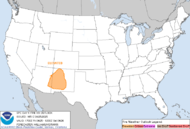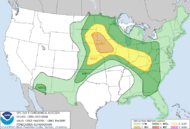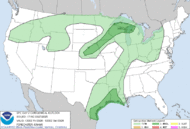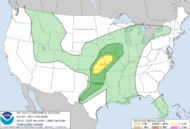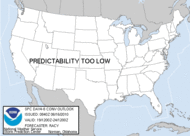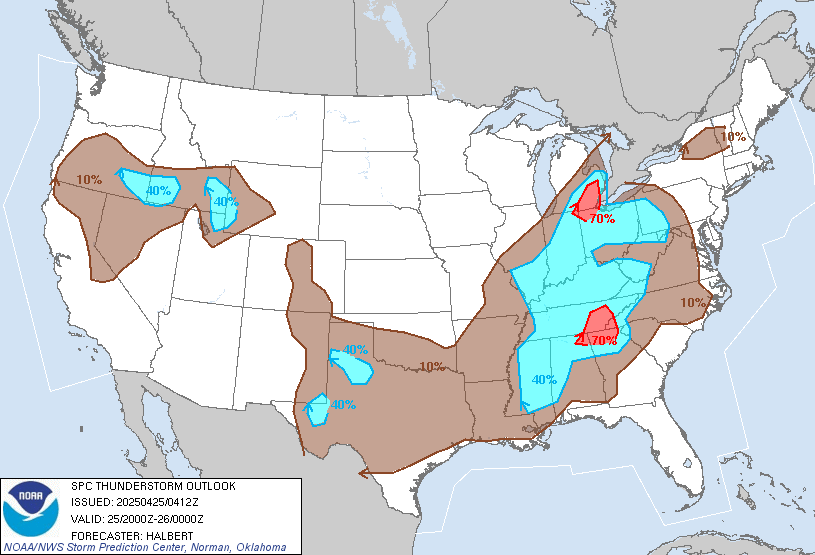In the first half of 2001 Lafayette SkyWarn began a major change. The change
allows anyone to help their community without leaving their home. As is common
in a lot of the country, SkyWarn had been an Ham Radio only group. The members
used Amateur Radio to communicate. The Lafayette SkyWarn Group decided to change
its structure to allow anyone to fully participate in the program. Under the
new program, anyone with a telephone can participate. And, it's fully flexible.
You can use your home phone, your cell phone, or your radio phone to communicate
with the SkyWarn group.
The local SKYWARN group is sponsored by the
Lafayette City-Parish Office of Homeland Security and Emergency Preparedness
(LFT OHS&EP).
Nationwide, SKYWARN is a plan sponsored by
the National Weather Service (NWS),
using volunteer
weather observers trained by NWS
for reporting
destructive thunderstorms or other severe, unusual,
or hazardous weather conditions.
As mentioned above, SkyWarn members are frequently
Ham Radio operators.
If you are a Ham (or want to become a Ham), the
537 System is available.
It is a unique repeater in this area that can provide
communications for SkyWarn.
But, with the new Lafayette SkyWarn design, you don't
need to be a HAM. All you need is a telephone.
Additional SkyWarn information includes a peek at
new ideas
and the home page from a
major metro SkyWarn group.
Have you seen the movie 'Twister'?
Do you want to be a storm chaser?
That's
NOT
what SkyWarn is about.
But you can read about the considerations necessary
to leave your home during severe weather by
clicking here.
The
SkyWarn National Homepage
page contains references to everything SkyWarn.
But, the
Tornado Project Online
has some of the best tornado pictures.
Training Materials
SkyWarn spotters take part in training classes to learn about
severe weather.
The latest and greatest is the FEMA Course
IS-271.
Not only will you learn about
Anticipating Hazardous Weather and Community Risk,
but you will be able to take a short test and receive
a Certificate of Achivement from FEMA.
The link to the Spotters Guide in this section
does not take the place of
training, but it gives you an overview of what spotters learn.
The links are a courtesy of
the National Weather Service in Norman, OK.
Click to see the
Spotters Field Guide.
The
Advanced Severe Storm Spotters Guide
is also available.
Do you have a weather radio?
Here is access to technical information and an interactive map of
NOAA Weather Radio Transmitter Sites and Frequencies.
It includes Louisiana and surrounding transmitters.
NEXRAD is a monumental improvement over the previous generation
of weather radars.
You need to know how to read the NEXRAD images
to make full use of the information.
Here is a
Radar Tutorial
so you can get the most from NEXRAD images.
Maybe you are just starting out and would like a
Basic Weather Tutorial
from the Navy.
How about a USA Today article on
Storm Systems and Fronts.
Or, maybe you need a
cloud tutorial.
We also have a
conversion guide
for temperature and pressure units,
also included is a standard altitude - temperature - pressure table.
You need to know more about Lightning?
We have
Frequently Asked Questions about Lightning.
Everyone needs to play it safe!
Hey, you are dealing with Mother Nature,
and she is capable of hurting you.
Please review
Project Safeside
to keep you ahead of the storm.
And for those who like to do it by the book, you can access the
Federal Meteorological Handbook #1
to see the nitty-gritty details of weather (U.S. Government style).
Do you need a copy of the
Lafayette SkyWarn Manual?
NOTICE: THIS MANUAL HAS NOT BEEN UPDATE TO THE NEW OPERATION !!
If you click on the link you can access our manual in PDF format.
It is large (about 3 to 4 MB) and will take a while to download the 105 pages of information.
General Information
SKYWARN is a nationwide network of volunteer severe weather observers.
The program is an effort to save lives and property during severe
weather emergencies.
All you need to do to become a member of the SKYWARN volunteer network
is an interest in watching the sky and a dedication to helping save lives.
The
National Weather Service
has offices at many locations around the country.
The NWS office that serves Lafayette Parish
is near Lake Charles Louisiana.
The doppler radar, called
NEXRAD
(NEXt generation RADar) is located in Calcasieu Parish.
NEXRAD was designed to improve detection of severe storms so that
the NWS can provide more accurate and timely warnings to the public.
SKYWARN is an integral part of this detection and warning process.
NEXRAD will help locate and track potentially severe and dangerous storms,
but it is SKYWARN spotters that report what the storm is actually doing
(trees blown down, a tornado on the ground,
flood waters washing out a bridge,
a dangerous glaze of ice on roads and wires).
SKYWARN spotters are trained to spot tornadoes,
funnel clouds, and severe thunderstorms.
They are told how to report hail,
strong winds, heavy rain, floods, and snow.
Forecasters combine information from spotters with that of radar,
satellite and other tools.
This information is then used to provide appropriate warnings for
communities downstream from the storm and to keep people
informed about what is happening and what steps they may need to take to
protect themselves.
Reporting Procedures for NWS Trained Members of SkyWarn
- Call the National Weather Service office
- tollfree at (800) 721-5739
- collect at (337) 477-3422
Note that these numbers may only be called collect to report severe
weather conditions
and
called normally for other business.
- Identify yourself
- Use your callsign and 'with Lafayette SkyWarn'.
Your callsign will be checked to see if you are an authorized spotter.
- Location of the event
- The Parish
- Your position relative to a known town/landmark
("7 miles west of Rayne")
- If the event is not occuring where you are, your position
relative to the event/storm ("looking 3 miles north of my location")
- Reporting Criteria (most important at the top)
- Tornado or Waterspout
- Funnel cloud
- Rotating wall cloud
- Hail of any size.
Measure size if possible, report largest size, most common size, and
depth of coverage.
- Damage, injuries, or loss of life and/or property caused by
floods, wind, hail, and tornadoes.
- Wind gusts of greater than or equal to 55MPH.
(If tree damage, determine the diameter of the limbs. Live tree limbs
1-2 inches in diameter many times indicates that winds in excess
of 55 MPH have occurred.)
- Rainfall of greater than 1/2 inch per hour.
- Time
- Time of the event/storm
- Duration of the event
- If the event is still in progress.
SkyWarn Works With ARES and RACES
The Amateur Radio Emergency Service (ARES),
a public service organization of the
American Radio Relay League (ARRL),
consists of licensed amateurs who have voluntarily
registered their qualifications and equipment for communications duty
when disaster strikes or for public events.
Additional information on Emergency Communications is contained in:
Other Emergency Services Information

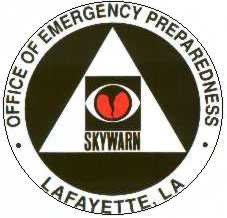
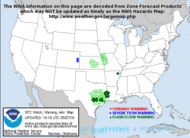


![[SPC CURRENT SVR/TOR WATCHES/WARNINGS]](http://www.spc.noaa.gov/products/watch/validww_sm.gif)
